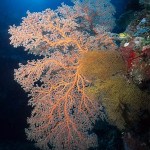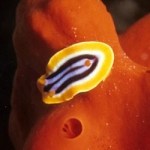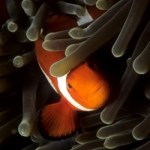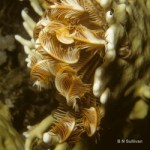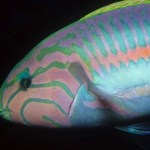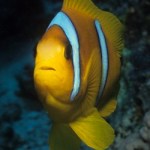Red Sea
I don't, in general, read my fellow science blogs. Not because I hate them, you understand, but because they talk about other stuff. But I was lead to Inventing excuses for a Bible story, and getting them published in a science journal? and was immeadiately struck by (a) how strident it seemed, and (b) how backwards it all seemed. (a) I can excuse: I'm sure I seem the same fairly often, but hopefully not too often (b). Side note: I was "accused" recently of being tedious in my writing on wikipedia, at which I vigourously protested. But it became clear that she actually meant "tendentious"…
Many animals in the sea have evolved colors and forms that allow them to blend in with their surroundings. Some animals use their camouflage to hide from predators -- and some predators use camouflage to fool their prey.
It can be difficult to photograph such animals, partly because it's often hard to find them in the first place. If you look carefully at the photo at right, you will be able to make out the shape of a small purplish slipper lobster (Parribacus antarcticus), right in the center of the photo.
The picture was taken inside an underwater cave in Hawaii, and the lobster was on…
Sea fans are among the most beautiful sights seen by divers. Gorgonian sea fans are Cnidarians that build colonies in branching formations that usually are fan-shaped, thus the common name.
Like the Nephtheid soft corals I wrote about recently here on Photo Synthesis, Gorgonians are octocorals: each polyp has eight pinnate tentacles which it uses to capture nutrients suspended in the water column. They are seen most often on reef crests, or jutting out from drop-offs or steep banks in locations where natural currents will sweep plankton and other organic nutrients across the polyps'…
Nudibranchs -- marine snails without shells -- make wonderful photo subjects for the macro photographer. They are small, colorful, and they move slowly (as snails are wont to do). That last characteristic is particularly welcome. Most fishes are in motion almost constantly, and non-sessile invertebrates tend to scurry hither and thither. It's nice to find a subject that is not only photogenic, but doesn't turn tail or flat out disappear before the photographer can focus the camera's lens!
It's always interesting to find out and record which critters feed on what. Here are some macro…
Many animals in the ocean seek shelter from predators by living on or among other animals. Among fishes, members of the Damselfish family (Pomacentridae) often seek protection this way. Some of these relationships also are commensal or even symbiotic.
One of the most well known symbiotic relationships in the marine world is that between anemones and fishes commonly known as 'clownfish' or 'anemonefish'. Clownfish form a subfamily, Amphiprioninae, of the Dameselfish family. Each of the twenty-some species in this subfamily lives symbiotically with one or more anemone species.
Both the…
Everyone knows that some terrestrial animals are active primarily at night and sleep most of the day, while others go about their business during daylight hours and rest when it's dark. For some reason, many people are surprised to learn that the same thing holds true for animals that live in the sea.
One of the many marine animals that works the night shift is the crinoid species pictured here: Lampometra klunzingeri, a member of the Mariametridae family. During daylight hours, these crinoids hide in crevices in the reef. Shortly before sunset, like clockwork, they emerge from their…
I like to photograph the faces of creatures that live in the sea. Here is a sampler of fish faces. All of these individuals belong to the Wrasse (Labridae) family. Most wrasses seem to have attractive markings on their faces, which show up well in close-up images like these.
Shown above: Thalassoma klunzingeri, from the Red Sea, about 15 cm (six inches) long. This one was photographed near Sharm el Sheikh, Egypt.
Shown above: Halichoeres hortulanus, about 23 cm (nine inches) long. Also from the Red Sea, this one was photographed at Ras Mohammed, at the tip of the Sinai Peninsula.…
New month, new topic here on Photo Synthesis: underwater photography.
For the next four weeks I will be presenting photos of marine invertebrates and fishes from warm water locations around the world. These photos are the product of what has been, for me, a long journey of discovery -- about the sea, about marine life, and about photography.
My photos are documentary in nature, rather than works of art. That is not to say that I don't strive for a certain level of eye appeal, but my purpose always has been to record which creatures live where, what they look like in their natural…
The Harrat Khaybar volcanic field in Saudi Arabia. Image courtesy of NASA, taken in 2008.
Now, I might take this report with a Volvo-sized grain of salt, but I've seen a few reports lately of an earthquake swarm going on in Saudi Arabia, near the Harrat Ash-Shaqqah in Al-Eis region (apparently near Madina, but I'm not 100% sure). I might normally just chalk this up to the tectonics of the Arabian Plate, however, the latest article I read this morning, Saleh Al-Muhawis, Director General of the Civil Defense in Madina Region mentioned this as the cause of the seismicity:
... magma (molten…
I'm always pleased to see more countries setting up volcanic monitoring networks. Well, I suppose I'm pleased when it is a volcanically-active country, I mean, Switzerland setting up one might be a little silly, but anyway. After last year's eruption of Jebel At Tair in the Red Sea, we were reminded that there are potentially active volcanoes in/near Arabian Peninsula countries like Yemen, so with the help of the Germany-Indonesian Tsunami Early Warning System, Yemen is setting up their own network to monitor volcanoes in the region. Little in the way of details were offered, but at…

